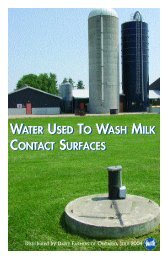Canadian Quality Milk On-Farm Food Safety Program - Centre ...
Canadian Quality Milk On-Farm Food Safety Program - Centre ...
Canadian Quality Milk On-Farm Food Safety Program - Centre ...
You also want an ePaper? Increase the reach of your titles
YUMPU automatically turns print PDFs into web optimized ePapers that Google loves.
<strong>Canadian</strong> <strong>Quality</strong> <strong>Milk</strong><br />
Store pesticides, treated seed and fertilizers separately and in<br />
original containers in a location where there is no livestock<br />
access or risk of contaminating milk, and according to provincial<br />
dairy regulations.<br />
• Crop or animal pesticides must not be stored in the milk<br />
house, unless registered for use in the milk house.<br />
• Pesticides, cleaners and other substances that are not for<br />
use on or in cattle must not be stored with livestock<br />
medicines and chemicals. They must be stored separately<br />
(e.g. another cupboard or different shelves). Pesticides<br />
should pose no risk of contaminating feed, milking<br />
equipment or products used on milk contact surfaces.<br />
• Access to the storage area must not be through the milking parlour or milk house<br />
because, if it was, a spill during transport could contaminate the parlour/milk<br />
house equipment resulting in a food safety hazard. If there are no other options,<br />
producers must be able to show how they can safely transport those products or<br />
they must re-locate them.<br />
Handle pesticides, treated seed, and fertilizers properly.<br />
• If any hose connected to the milk house or barn water system is used to fill<br />
pesticide sprayers or containers, use an anti-backflow device or air-gap on the<br />
hose to effectively prevent back-siphoning; hence, contamination of lines or<br />
cisterns.<br />
• Never mix any pesticides, treated seed or fertilizers near dairy feed or milking<br />
facilities. Do so only in a properly designed storage or handling facility.<br />
• Never clean or rinse any equipment related to the use of pesticides, treated<br />
seeds or fertilizers near dairy feed or milking facilities.<br />
• Dispose of containers properly. Triple rinse to flush remaining<br />
pesticide. Bring empty and rinsed containers to designated<br />
disposal areas.<br />
• Follow proper spill clean-up procedures. Check product<br />
Material <strong>Safety</strong> Data Sheets (MSDS) for specific instructions.<br />
For further information<br />
contact your provincial<br />
or regional authority on<br />
pesticides.<br />
1.3 NUTRIENT MANAGEMENT<br />
1.3.1 Cattle Environment<br />
1.3.1.1 Housing<br />
The goal of dairy cattle housing is to provide an environment that is clean,<br />
dry, comfortable and safe. A clean environment will help reduce hazards<br />
to milk safety that are related to dirty udders (e.g. bacteria).<br />
Cattle housing must be designed and maintained to ensure the cleanliness<br />
June 2010 1—5
















